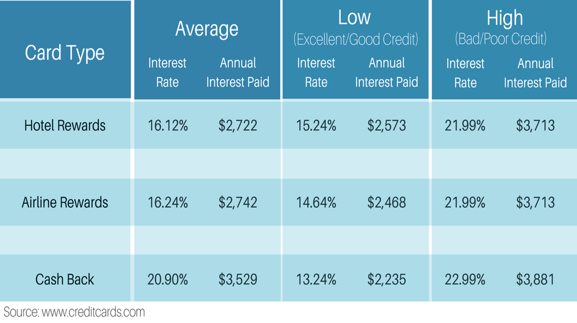Latest Posts
Your money should work for you.
Get the latest tips on how to plan for retirement and make better financial decisions.
Don't worry... we will NOT spam you!
There are a lot of champions for credit card rewards programs - if you’re going to be spending the money anyway, you should take advantage of receiving free stuff in return, right? In theory, the idea of a rewards card is very appealing, and can often feel like a small win whenever you redeem your points, miles, cash, or whatever it may be.
For those who are able to use a credit card and pay it off in full every month without fail, then sure, go for it – beat the credit card companies at their own game. However, studies have shown the majority of Americans are not following this process, making the perks that come with a rewards card fail to outweigh the negative effects of carrying a balance.
According to a 2015 report by the Federal Reserve Bank of Boston, 65% of credit card users carry a revolving balance, averaging $16,883 per household as of 6/30/2017 – a number that is continuing to rise year after year.
Remember, credit card companies are not our friends, and there is a reason they are so profitable. They have successfully shifted their narrative to focus on their rewards programs, luring us (and the new revenue we’ll create for them when we inevitably don’t make full payments) into their system. As a result, we end up paying them for those “free” perks.
The truth is, we aren’t asking the right questions when we open new cards. Most of us jump immediately to the rewards we’ll receive. However, we really should be asking about interest rates (not to mention fees). The better the credit card perks, typically the higher the interest rate (and ultimately the more money in the credit card company’s pocket).
For example, the average interest rate on an airline travel rewards card is currently 16.24%, and that’s just the average rate. Depending on your credit score, you may be paying as high as 21.99% for your rewards card. If you maintain the average $16,883 worth of debt on that card at the 16.24% average interest rate, you will be paying the credit card company an extra $2,742 a year. Do you believe you are receiving $2,742 worth of airline miles from your rewards program every year?
Overall, if you are carrying a balance month-to-month, no matter the amount, you are losing. Rather than spending your time, energy, and frankly money, on trying to scope our great deals through your credit cards, we strongly believe it is imperative to get back to the basics instead.
- Create a monthly spending plan – By mapping out where each dollar will go over the course of the month, and tracking your day-to-day expenses, you will establish a solid grasp on your spending habits. You might find it is easier to prevent yourself from overspending when you already have a detailed roadmap for where you want your money to end up.
- Build up your emergency fund – Too often when faced with a sudden expenditure, such as a $500 car repair, we turn to our credit cards and perpetuate the never-ending cycle of debt. While it may take some time (no one expects you to drop three- to six months’ worth of expenses into a rainy day fund right away), you’ll find having a cushion for when things aren’t all sunshine and rainbows can help relieve future money woes and stress.
- Create a self-funded rewards program – If you don’t have to pay $2,000 or more in interest to a credit card company annually, what could you do with those extra dollars? Set a few S.M.A.R.T. goals for yourself, establish a course of action, and enjoy the rewards guilt-free.
We know what you’re probably thinking. “Life without a credit card? You must be crazy!” We understand that it’s fairly unreasonable to expect everyone to go back to the days of cash-only. However, when you are looking to open a new account, we suggest you follow a few key steps:
- Shop around to find the right card – You can get pretty creative if you start looking in places besides the “Best Rewards Cards for…” lists. For example, have you reached out to any credit unions to see what type of deals they are offering? Finding a card with even a one or two-percent lower interest rate can have a significant impact on how much you pay to the credit card company in the event that you do build a balance.
- Treat your credit card like it’s a debit card – If you followed our suggestion to create a monthly spending plan, then you should know how much money you have coming in and where those dollars will be going over the course of a month. As you charge items to your credit card, pay it off as if you had spent cash. Your number one priority should be to make sure you are not building a balance you cannot pay off immediately.
- Make sure you read the fine print – What are all the fees associated with your card? Is there any post-introductory offer switcheroo? What is the interest rate and is it fixed or variable? You might be surprised by how much flexibility the credit card companies give themselves when it comes to what they are charging you.
Fellow blogger, Josh from Peer Loans Online covers the 5 reasons credit card rewards programs aren't worth it. He pulls attention to that if rewards are properly managed they can work, however, most people will never redeem their rewards, annual fees outweigh the benefits, and you'll still spend too much money with credit cards.
If you already have a credit card and are carrying a balance, you’re not alone. Still follow the steps we have outlined: build a spending plan so you are not putting any new money onto your existing balance, then create a realistic game plan to become credit card debt-free. Overall, we have one ultimate goal – to become the credit card user the credit card company hates.




